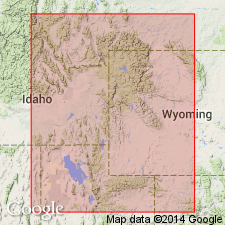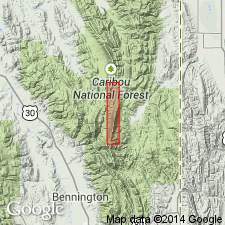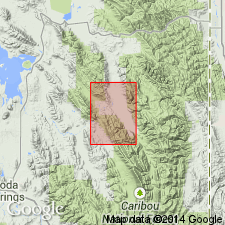
- Usage in publication:
-
- Lanes Tongue*
- Modifications:
-
- Named
- Dominant lithology:
-
- Redbeds
- AAPG geologic province:
-
- Wasatch uplift
- Uinta basin
- Green River basin
Summary:
Named as a tongue of the Ankareh formation after Lanes Creek [in the Lanes Creek quad.], Caribou Co., ID on the Wasatch uplift. The best exposures are at the south end of Grays Range, a mile west of the junction of Lanes Creek and Sheep Creek, southeast ID. No type locality designated. Described as a 440 ft thick redbed tongue that separates Portneuf limestone member (rank reduced from formation) of Thaynes formation (formerly Thaynes group). [No other descriptive information included in report.] Cross sections. Block diagram. Correlation chart. Identified in southeast ID in the Grays Range and east of Bear Lake in southwest WY in the Greater Green River basin at Swift Creek, Cokeville, and Muddy Creek, and in northern UT on the Wasatch uplift and northern Uinta basin as far east as the Duchesne River. Not present at Fort Hall. Assigned to the Lower Triassic.
Source: GNU records (USGS DDS-6; Denver GNULEX).

- Usage in publication:
-
- Lanes tongue*
- Modifications:
-
- Areal extent
- AAPG geologic province:
-
- Wasatch uplift
Summary:
Pg. 42-45, pls. (geol. maps, columnar section). Author follows Kummel's (1954) nomenclature. Lanes tongue of Ankareh formation. In this area it is a dark-red and maroon shale and very fine-grained calcareous siltstone, 450+/- feet thick. Lies within the Lower Triassic Portneuf limestone member of Thaynes formation, nearly 600 feet below Wood shale tongue of Ankareh formation. Age is considered Early Triassic. Age of Ankareh is considered Triassic.
Measured section on ridge on north side of Preuss Creek, in sec. 15, T. 11 S., R. 45 E., Caribou Co., ID.
[GNC remark (July 25, 2016): Although the rank and lithologic terms are lower case, these are formal names.]
Source: Publication.

- Usage in publication:
-
- Lanes Shale Tongue*
- Modifications:
-
- Overview
- AAPG geologic province:
-
- Wasatch uplift
Summary:
Mapped as a lower tongue of the Ankareh Formation above the lower part of the Portneuf Limestone Member of the Thaynes Formation and below the upper part of the Thaynes in the north-central and east-central part of quad. in Caribou Co., ID on the Wasatch uplift. Consists of red to red-brown, some yellow-brown and gray, very fine to fine grained, thin bedded, locally ripple marked sandstone interbedded with red-brown shale and siltstone. A few thin limestones locally near base. Assigned to the Early Triassic.
Source: GNU records (USGS DDS-6; Denver GNULEX).
For more information, please contact Nancy Stamm, Geologic Names Committee Secretary.
Asterisk (*) indicates published by U.S. Geological Survey authors.
"No current usage" (†) implies that a name has been abandoned or has fallen into disuse. Former usage and, if known, replacement name given in parentheses ( ).
Slash (/) indicates name conflicts with nomenclatural guidelines (CSN, 1933; ACSN, 1961, 1970; NACSN, 1983, 2005, 2021). May be explained within brackets ([ ]).

